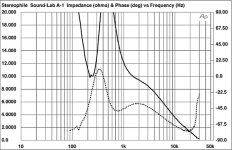FLOOR LOUDSPEAKER REVIEWS
Sound-Lab A-1 electrostatic loudspeaker Measurements
Sidebar 6: Measurements
To investigate the answer to Dick's question, I measured the A-1's impedance magnitude at three settings of the Brilliance Control (BC) with DRA Labs' MLSSA system. With the BC set at Maximum (pot wide open), I obtained the curves in fig.1. Although the magnitude of the impedance is above 10 ohms from the upper bass to 2kHz, and well above 30 ohms in the bass, note the drop in the mid-treble and above. The cursor indicates a punishingly low 1.3 ohms at 20kHz with an equally punishing phase angle of –75.5°, dropping even further to just a small fraction of an ohm at ultrasonic frequencies. This measurement necessarily includes the resistance of the speaker cables DO was using (TARA Labs Rectangular Solid Core); as the margin of error in my measurement is probably around a fraction of ohm, it's quite possible that the A-1 presents amplifiers with a complete short circuit above the audio range. Fundamentally, therefore, in electrical terms, the A-1 with its BC set to maximum is nothing more than a large capacitor. If this isn't hell for a power amplifier, I don't know what is (footnote 1). No wonder DO's amps were choking.


